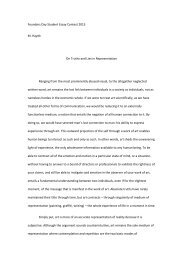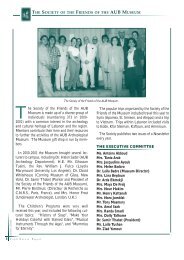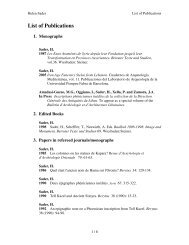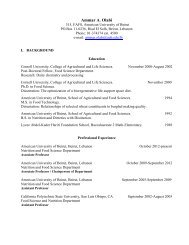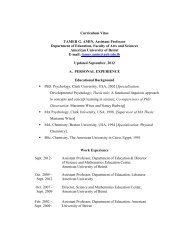The IX t h Makassed Medical Congress - American University of Beirut
The IX t h Makassed Medical Congress - American University of Beirut
The IX t h Makassed Medical Congress - American University of Beirut
Create successful ePaper yourself
Turn your PDF publications into a flip-book with our unique Google optimized e-Paper software.
T h e I X t h M a k a s e d M e d i c a l C o n g r e s s<br />
ADVANCES IN PEDIATRIC SICKLE CELL DISEASE<br />
Miguel R. Abboud MD<br />
Sickle cell disease is an inherited hemoglobinopathy affecting over 80,000 people in the US and<br />
many more worldwide including the Arab world. <strong>The</strong> myriad clinical complications <strong>of</strong> sickle cell<br />
disease have their starting point in a single amino acid substitution in the b chain <strong>of</strong> human<br />
hemoglobin. This substitution results is in sickle hemoglobin (Hb S) that polymerizes under conditions<br />
such as hypoxemia and acidosis. <strong>The</strong> polymerization causes perturbations in the erythrocyte<br />
integrity which lead to hemolysis and vaso-occlusion. Recently, two clinical phenotypes <strong>of</strong> sickle<br />
cell disease have been described. <strong>The</strong> hemolysis associated phenotype is characterized by<br />
severe anemia, leg ulcers and pulmonary hypertension. When vaso-occlusion predominates the<br />
clinical picture is defined by severe painful episodes, acute chests syndrome, splenic infarction,<br />
stroke and avascular necrosis <strong>of</strong> target joints. <strong>The</strong> disease is also characterized by endothelial<br />
dysfunction and a vasculopathy. <strong>The</strong> course <strong>of</strong> the disease is very unpredictable but for many<br />
patients is associated with significant morbidity, decreased life expectancy and poor quality <strong>of</strong><br />
life. <strong>The</strong> risk <strong>of</strong> early mortality is highest in older patients with a history <strong>of</strong> severe complication such<br />
a recurrent acute chest syndrome, renal failure and pulmonary hypertension.<br />
Chronic transfusions are effective in preventing many complications <strong>of</strong> sickle cell disease but<br />
this modality <strong>of</strong> therapy has significant complications such as iron overload and alloimunization.<br />
Hydroxyurea has been show to be very effective in ameliorating certain manifestations <strong>of</strong> the<br />
disease, such as painful crises and acute chest syndrome. This modality <strong>of</strong> therapy also and leads<br />
to a longer life expectancy. Many patients however will have poor response to hydroxyurea and<br />
still require other forms <strong>of</strong> therapy. Like for thalassemia the only curative modality is correction <strong>of</strong><br />
the genetic defect by allogeneic hematopoietic cell transplantation. This presentation will focus<br />
on recent findings in the pathophysiology and therapy <strong>of</strong> sickle cell disease.<br />
ITP IN CHILDREN : AN UPDATE<br />
Françoise Mazingue MD<br />
ITP is frequent in young children, characterised by severe isolated thrombocytopenia and<br />
presence <strong>of</strong> auto antibodies to platelets. <strong>The</strong> risk <strong>of</strong> severe bleeding is <strong>of</strong>ten over estimated and<br />
seriously impacts the way <strong>of</strong> life <strong>of</strong> the child and his family, more than the disease itself would do.<br />
Most <strong>of</strong> ITP are post infectious (viral or post vaccination). Since a few years, ITP management<br />
has been modified. Bone marrow examination is usually not necessary for diagnosis if clinical<br />
examination and blood count exclude leukemia. Treatment is based on Buchanan score and<br />
platelets count. In case <strong>of</strong> mild bleeding and platelets >10 000/mm3 one can just clinically survey,<br />
hospitalization is not necessary.<br />
On the other hand, in case <strong>of</strong> severe hemorrhage or life threatening bleeding, treatment will<br />
associate IV Ig to steroids (4mg/kg, during 4 days), sometimes platelets transfusions are necessary.<br />
In case <strong>of</strong> refractory ITP, one can have to use Vincristine and sometimes Rituximab. Chronic ITP<br />
is lasting for more than 12 months. <strong>The</strong> diagnosis <strong>of</strong> primary chronic ITP remains one <strong>of</strong> exclusion.<br />
<strong>The</strong>re are a lot <strong>of</strong> secondary ITP. It’s necessary to establish diagnosis with accuracy to adapt<br />
56






